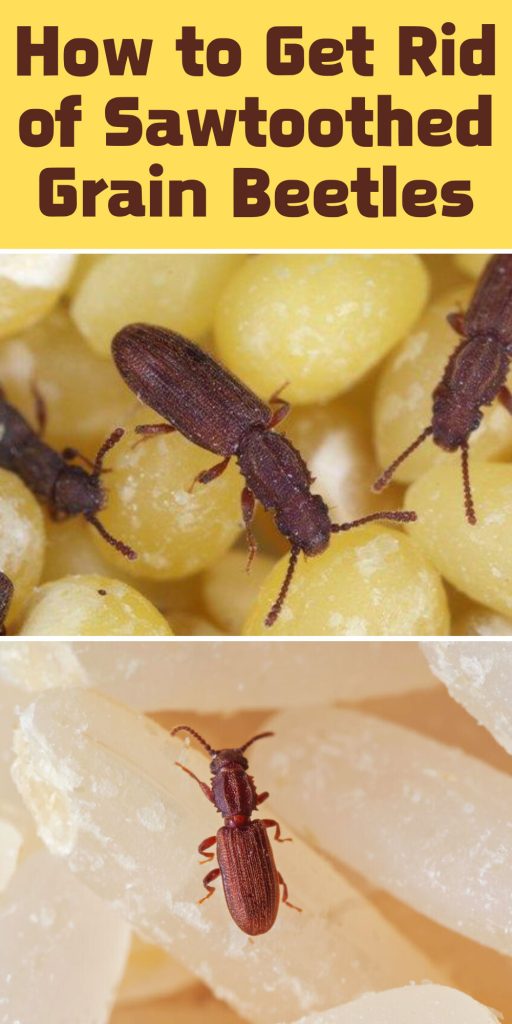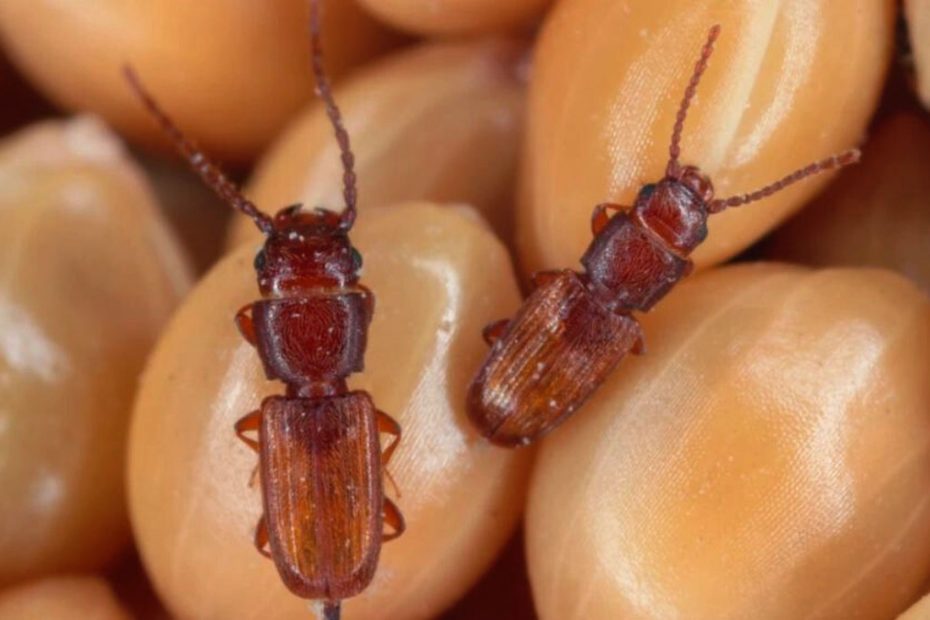Discovering sawtoothed grain beetles in your pantry can be a nightmare. These tiny pests can wreak havoc on your stored food items, making them unsafe to consume. But don’t worry—getting rid of these unwelcome guests is entirely possible with the right approach.
You’ll learn effective methods to eliminate sawtoothed grain beetles from your home and prevent their return. From identifying their hiding spots to implementing practical solutions, we’ve got you covered. Say goodbye to these pesky intruders and reclaim your pantry with confidence.
Key Takeaways
- Identification and Life Cycle: Recognize sawtoothed grain beetles by their narrow, flat bodies with six saw-like projections on each side of their thorax. Understanding their life stages (egg, larva, pupa, adult) aids in managing infestations.
- Common Infestation Areas: These beetles thrive in pantry items like flour, cereals, dried fruits, and pasta. Regularly inspect and clean storage containers and spill zones to prevent contamination.
- Preventative Measures: Store food in airtight containers, practice regular cleaning, and seal cracks and crevices in your pantry. These steps are crucial to keeping your food safe from beetles.
- Natural Remedies: Use diatomaceous earth, essential oil sprays, and temperature treatments to eliminate beetles without chemicals. These methods are safe and effective for household use.
- Chemical Treatments: In cases where natural remedies are insufficient, use pyrethrin-based sprays, permethrin insecticides, or deltamethrin dust. Always follow safe application practices to avoid contamination.
- Professional Help: Seek professional pest control services if infestations are severe, widespread, or recurrent. Ensure the pest control company is certified, experienced, and employs effective methods suitable for food storage areas.

Understanding Sawtoothed Grain Beetles
Sawtoothed grain beetles, or Oryzaephilus surinamensis, are common pantry pests. You might find them in stored foods, causing contamination and spoilage.
Identification
Sawtoothed grain beetles are small, flat, and brown. They measure about 2.5-3.0 mm in length. To identify them, look for the following characteristics:
- Shape: Narrow, flat body
- Color: Light to dark brown
- Size: Approximately 2.5-3.0 mm
- Distinctive Features: Six saw-like projections on each side of the thorax
These beetles can easily enter packaging through small cracks and seams.
Life Cycle
Understanding the life cycle helps in managing infestation. The beetle’s life stages include:
- Egg: Females lay around 45-285 white, oblong eggs on food sources.
- Larva: Hatch in 3-6 days and prefer to remain in grain kernels.
- Pupa: Develop into pupae under loose grain kernels or surface crevices.
- Adult: Emerge within 3-4 weeks, live up to 6-10 months.
Conditions such as temperature and food availability affect their development speed.
Common Infestation Areas
Sawtoothed grain beetles thrive in various stored products. Check these common infestation areas:
- Pantry items: Flour, cereals, dried fruits, nuts, and pasta.
- Storage containers: Plastic, metal, and paper packaging with small openings.
- Spill zones: Areas around where food residue might accumulate.
Ensure you seal packages tightly and clean pantry shelves regularly to prevent infestation.
By knowing their appearance, life cycle, and common hiding spots, you can take effective steps to control and eliminate sawtoothed grain beetles from your pantry.
Preventative Measures
Preventing sawtoothed grain beetles from infesting your pantry involves several strategies. Implementing these measures helps keep your stored food safe and your pantry beetle-free.
Proper Food Storage
Proper storage of food products is essential to deter sawtoothed grain beetles. Follow these storage tips:
- Airtight Containers: Store dry goods like flour, cereals, dried fruits, nuts, and pasta in airtight containers. These containers prevent beetles from accessing food sources.
- Glass or Heavy-Duty Plastic: Use glass or heavy-duty plastic containers, as beetles can chew through thin plastic or cardboard.
- Original Packaging: For unopened items, check packaging for any tears or openings before placing them in your pantry.
- Small Portions: Buy food in quantities that you will use quickly, reducing the risk of prolonged storage that can attract beetles.
Regular Cleaning Practices
Regular cleaning practices help remove food residues that attract beetles. Carry out the following cleaning routine:
- Shelves and Cabinets: Wipe shelves and cabinets regularly with a damp cloth to remove crumbs and food residues.
- Vacuuming: Use a vacuum cleaner to remove debris from pantry corners and shelf edges.
- Inspection: Routinely inspect pantry items for signs of infestation. Discard any packages showing beetle activity.
- Disposal of Old Products: Periodically check expiration dates and dispose of old or unused products that might attract beetles.
Sealing Entry Points
Sealing entry points blocks beetles from entering your pantry. Check these areas:
- Cracks and Crevices: Seal cracks and crevices in walls, shelves, and floors using caulk or sealant.
- Windows and Doors: Ensure windows and doors in and around the pantry are well-sealed and free of gaps.
- Ventilation Openings: Cover ventilation openings with fine mesh screens to prevent beetles from entering.
Taking these preventative measures significantly reduces the risk of sawtoothed grain beetle infestations.
Natural Remedies
Eliminate sawtoothed grain beetles using natural remedies that are safe and effective. The following methods can help you control and prevent infestations without harsh chemicals.
Diatomaceous Earth
Diatomaceous earth, a fine powder made from fossilized algae, is effective against insects.
How to Apply:
- Sprinkle Thin Layer: Apply a thin layer of diatomaceous earth to shelving and pantry corners.
- Target Infested Areas: Focus on cracks and crevices where beetles hide.
- Leave for Several Days: Allow the powder to sit for several days to dehydrate the beetles.
- Vacuum Residue: After treatment, vacuum up the powder and dead insects.
Essential Oils
Certain essential oils act as natural insect repellents through their strong scents.
Types of Effective Oils:
- Peppermint Oil: Repels adult beetles.
- Eucalyptus Oil: Deters beetles from infesting food.
- Lavender Oil: Keeps beetles from laying eggs.
Application Methods:
- Create a Spray: Mix 15-20 drops of essential oil with water in a spray bottle.
- Spray Shelves and Containers: Lightly mist shelves and the exterior of food containers.
- Refresh Regularly: Reapply the spray every few days to maintain effectiveness.
Temperature Treatments
Temperature extremes kill sawtoothed grain beetles effectively if used correctly.
Freezing:
- Bag Infested Items: Place contaminated food items in sealable plastic bags.
- Freeze for Four Days: Store the bags in the freezer at 0°F (-18°C) for at least four days.
- Return to Pantry: Once thawed, ensure items are in airtight containers.
- Heat Treatment: Place items in an oven-safe dish.
- Set Oven to 140°F (60°C): Heat for one hour.
- Cool Completely: Allow to cool before returning to storage.
Using natural remedies, you can maintain a beetle-free pantry safely and effectively. Employ diatomaceous earth, essential oils, and temperature treatments to manage and prevent infestations.
Chemical Treatments
Chemical treatments serve as an effective solution to eradicate sawtoothed grain beetles when natural methods don’t suffice. Using these treatments requires caution and adherence to safety guidelines.
Insecticide Options
For addressing beetle infestations, several insecticides are designed for safe use around food storage areas. Understanding your options helps you make informed decisions.
- Pyrethrin-Based Sprays: These sprays are derived from chrysanthemum flowers, offering a natural yet potent way to kill beetles. They’re safe for use in pantries and pose minimal risk to humans when applied correctly.
- Permethrin Insecticides: Synthetic variations of pyrethrins, permethrin insecticides last longer and provide a residual effect. They’re effective for ongoing protection but require careful application to avoid contamination.
- Deltamethrin Dust: A powerful insecticide that remains effective for several weeks. Deltramethrin dust is useful for treating cracks and crevices in pantry areas where beetles may hide.
Safe Application Tips
Applying insecticides safely ensures the effectiveness of the treatment while minimizing health risks. Follow these guidelines for a secure application process.
- Read Labels Thoroughly: Each insecticide comes with specific instructions. Read and follow these guidelines to ensure safe usage.
- Remove Food Items: Before applying treatments, empty your pantry. Store food in airtight containers outside the area being treated.
- Wear Protective Gear: Use gloves and masks to protect yourself from inhalation or direct contact with chemicals.
- Ventilate the Area: Ensure proper ventilation during and after application to reduce inhalation risks.
- Focus on Hidden Spots: Apply insecticides to cracks, crevices, and under shelves where beetles might hide. Avoid spraying directly on surfaces where food is placed.
Carry out these chemical treatments responsibly to reclaim your pantry from sawtoothed grain beetles. Use the right products and follow safety measures to ensure a pest-free environment.
When to Call a Professional
Handling sawtoothed grain beetles can often be managed with diligent cleaning, proper storage, and strategic use of both natural and chemical treatments. But, understanding when professional intervention is necessary is crucial to maintaining a pest-free pantry.
Evaluating Infestation Severity
Determine the extent of infestation to decide if expert help is required:
- Visual Confirmation: If large numbers of beetles persist even though repeated cleaning and treatments, it may indicate a deep-seated problem.
- Distribution: Widespread beetle presence across multiple pantry items and rooms often signifies a severe infestation.
- Recurrence: Frequent reinfestations, even after thorough cleaning efforts, suggest the need for professional evaluation.
Choosing a Pest Control Service
Selecting the right pest control service ensures effective and safe elimination:
- Certification: Verify the company’s licenses and certifications ensure they adhere to industry standards.
- Experience: Choose services with a proven track record in addressing pantry pests, particularly grain beetles.
- Methods: Inquire about their treatment approaches, ensuring they integrate both chemical and non-chemical methods suited for food storage areas.
- Reputation: Read reviews and ask for references to gauge reliability and customer satisfaction.
When faced with severe, widespread, or recurrent infestations, professional pest control services can provide comprehensive solutions, minimizing beetle risk and restoring your pantry’s safety.
Conclusion
By taking proactive steps to manage sawtoothed grain beetles, you can protect your pantry from these persistent pests. Implementing proper food storage, maintaining cleanliness, and using natural remedies will help keep these beetles at bay. If natural methods aren’t enough, chemical treatments provide an effective alternative. Remember to follow safety guidelines when applying insecticides. When infestations become overwhelming, don’t hesitate to call a professional pest control service. With these strategies, you’ll maintain a beetle-free pantry and ensure your stored food remains safe and uncontaminated.
Frequently Asked Questions
What are sawtoothed grain beetles?
Sawtoothed grain beetles (Oryzaephilus surinamensis) are small, flat, brown pantry pests about 2.5-3.0 mm in length. They are characterized by six saw-like projections on each side of their thorax.
Where do sawtoothed grain beetles typically infest?
These beetles commonly infest pantry items such as flour, cereals, dried fruits, nuts, and pasta. They also hide in storage containers with small openings and spill zones with food residue.
How can I prevent a sawtoothed grain beetle infestation?
Prevent infestations by using airtight containers, checking original packaging for damage, buying food in small portions, and maintaining regular cleaning practices like wiping shelves and inspecting pantry items.
What are natural remedies to eliminate sawtoothed grain beetles?
Natural remedies include using diatomaceous earth and essential oils like peppermint, eucalyptus, and lavender. Temperature treatments, such as freezing or heating infested items, are also effective.
Are chemical treatments safe for eliminating sawtoothed grain beetles?
Yes, chemical treatments can be safe if used correctly. Options include pyrethrin-based sprays, permethrin insecticides, and deltamethrin dust. Follow label instructions, wear protective gear, and ensure proper ventilation.
When should I call a professional pest control service?
Consider calling a professional if you see large numbers of beetles, notice widespread presence across multiple pantry items, or experience frequent reinfestations. Check for certifications and reviews when selecting a service.
